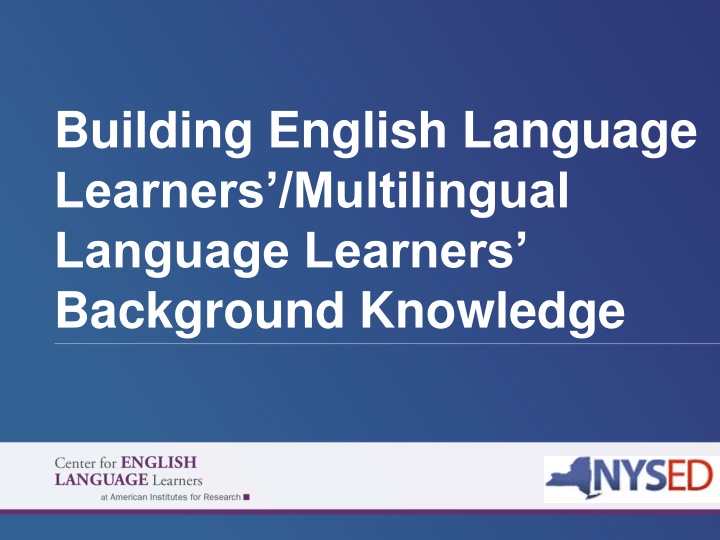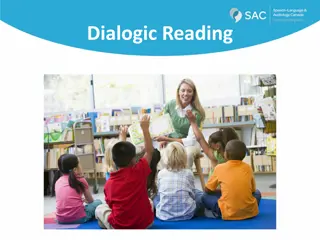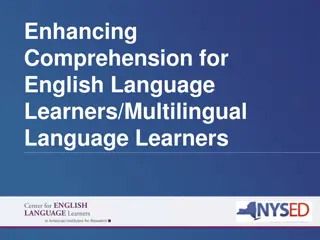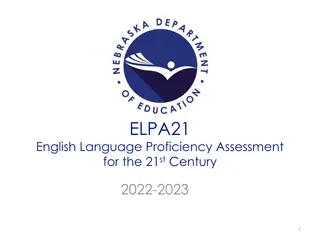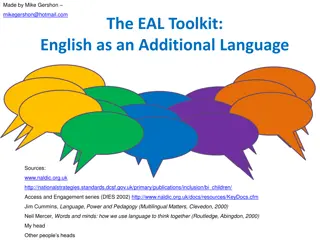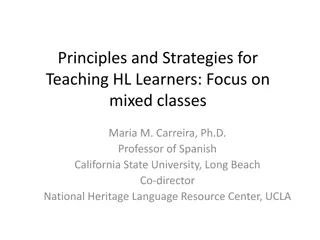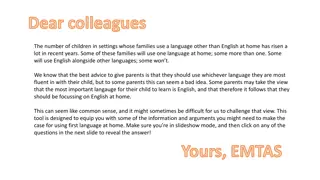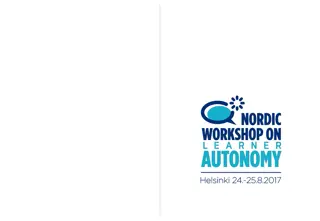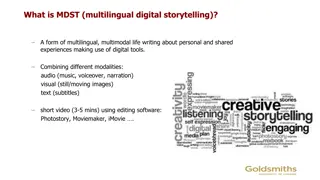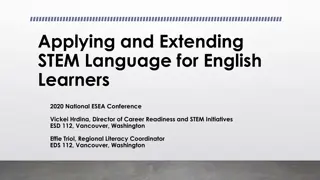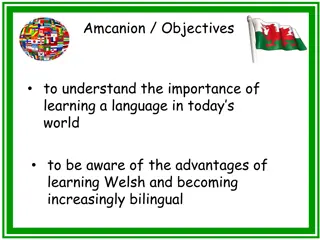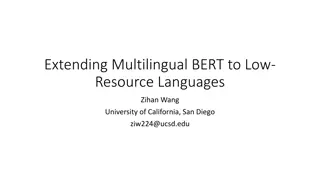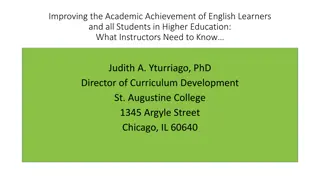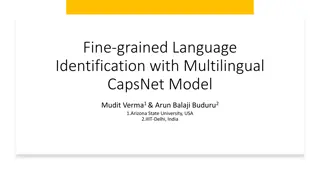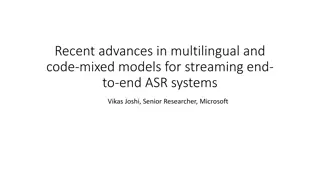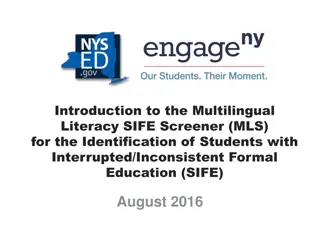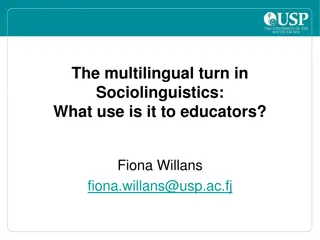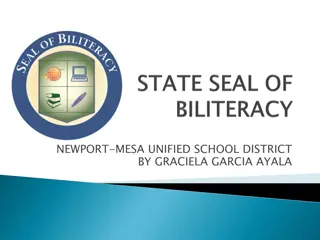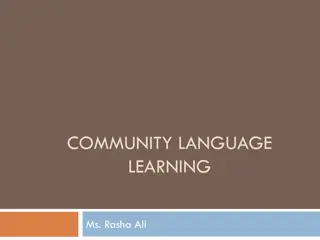Effective Strategies for English Language Learners/Multilingual Learners
Welcome to the presentation series sponsored by the New York State Education Department Office of Bilingual Education and World Languages. This first presentation focuses on building background knowledge to support teachers in scaffolding English Language Arts instruction for ELLs/MLLs. Discover methods for developing background knowledge, finding resources, and scaffolding effectively. The goal is to create a balanced learning environment for students with a variety of texts and discussions to enhance language development and knowledge building.
Uploaded on Sep 11, 2024 | 1 Views
Download Presentation

Please find below an Image/Link to download the presentation.
The content on the website is provided AS IS for your information and personal use only. It may not be sold, licensed, or shared on other websites without obtaining consent from the author.If you encounter any issues during the download, it is possible that the publisher has removed the file from their server.
You are allowed to download the files provided on this website for personal or commercial use, subject to the condition that they are used lawfully. All files are the property of their respective owners.
The content on the website is provided AS IS for your information and personal use only. It may not be sold, licensed, or shared on other websites without obtaining consent from the author.
E N D
Presentation Transcript
Building English Language Learners /Multilingual Language Learners Background Knowledge
Welcome! This is the first presentation in a series of 3 sponsored by the New York State Education Department Office of Bilingual Education and World Languages (OBEWL). The goal is to support teachers in scaffolding English language Arts instruction for English language learners/Multilingual language learners (ELLs/MLLs). This presentation focuses on building background knowledge The other two presentations focus on: #2 building vocabulary #3 supporting comprehension during close reading. 2
Welcome! Examples of lessons that use these strategies can be found in the Scaffolding Instruction for English Language Learners: Resource Guides EngageNY website: https://www.engageny.org/resource/scaffolding- instruction-english-language-learners-resource-guides- english-language-arts-and 3
Welcome! Ideally, you will view this presentation as part of a school- based professional learning community (PLC). This is an interactive presentation that includes several activities and partner talks. When you see the following image, pause the webinar and complete the activity or partner talk as a small group or with a partner. 4
Partner Talk Familiarize yourself with other members of your group. Share with the following information: What grade(s) do you teach? Approximately how many ELLs/MLLs do you serve? What are the English proficiency levels of the ELLs/MLLs that you provide services to? 5
Overview of Presentation Exemplar lesson Determine the background knowledge required Methods for developing background knowledge Find and adapt resources to develop background knowledge Scaffold background knowledge 6
Next Generation Learning Standards Students should experience a balance of literature and informational texts in the context of instruction designed to create opportunities for learners to engage with a variety of topics, texts, and in discussions about texts that support language development and knowledge building. Creating this learning environment for readers can take a variety of formats, including shared readings, paired readings, independent readings and other learning activities that incorporate literacy materials, talking, and writing. Because each reader brings different skills and background knowledge to their reading experiences, a text that is complex for one reader may be accessible to a peer in the same classroom. For this reason, educators should provide scaffolding and support as needed to allow all students to access grade-level texts. Source: http://www.nysed.gov/common/nysed/files/n ys-next-generation-ela-standards.pdf 7
Anchor Standards Comprehension and Collaboration Standard 1: Prepare for and participate effectively in a range of conversations and collaborations with diverse partners; express ideas clearly and persuasively, and build on those of others. Standard 2: Integrate and evaluate information presented in diverse media and formats (including visual, quantitative, and oral) Presentation of Knowledge and Ideas Standard 3: Present information, findings, and supporting evidence so that listeners can follow the line of reasoning. Ensure that the organization, development, and style are appropriate to task, purpose, and audience. 8
Anchor Standards Vocabulary Acquisition and Use Standard 4: Determine or clarify the meaning of unknown and multiple- meaning words and phrases by using context clues, analyzing meaningful word parts, and consulting general and specialized reference materials, as appropriate. Standard 5: Demonstrate understanding of figurative language, word relationships and nuances in word meanings. 9
Exemplar Lesson The Value of Sports in People s Lives 10
Its Not Just a Game! TEXT Whether you run a race, bounce a basketball, or hurl a baseball home, you do it because it s fun. Some scientists claim play is a natural instinct just like sleep. That might explain why sports are likely to be as old as humanity. Some claim sports began as a form of survival. Prehistoric man ran, jumped, and climbed for his life. Hunters separated themselves by skill, and competition flourished. Wall paintings dating from 1850 BC that depict wrestling, dancing, and acrobatics were discovered in an Egyptian tomb at Bani Hasan. The ancient Greeks revolutionized sports by holding the world s first Olympic games at Olympia in 776 BC. But it wasn t until the early nineteenth century that sports as we know them came into play. (Pardon the pun!) Modern sports such as cricket, golf, and horse racing began in England and spread to the United States, Western Europe, and the rest of the world. These sports were the models for the games we play today, including baseball and football. All organized sports, from swimming to ice hockey, are considered serious play. There are rules to obey, skills and positions to learn, and strategies to carry out. But Peter Smith, a psychology professor at Goldsmiths, University of London, and author of Understanding Children s Worlds: Children and Play (Wiley, 2009), says, Sport-like play is usually enjoyable, and done for its own sake. 11
Determine the Background Knowledge Required 12
Determine the Background Knowledge Required Preview the text to determine whether there are areas of background knowledge students might lack. Background knowledge might consist of cultural, historical, chronological, or spatial context for the anchor text. Consider background knowledge students might have acquired that would help them understand the anchor text. Not all texts require the development of background knowledge. 13
Partner Talk Think about the ELLs/MLLs you have taught. Look at the text It s Not Just a Game! on page 1 of your handout. For which topics might you want to enhance the background knowledge of ELLs/MLLs newly arrived in the United States? Why might it be necessary to enhance this background knowledge? What specialized areas of knowledge related to this text might your ELLs/MLLs bring to the classroom that they could share with other classmates? 14
Methods for Developing Background Knowledge 15
Methods for Developing Background Knowledge Identify the key information or facts needed by the students to understand a passage. Draw from a variety of sources e.g., auxiliary texts, video clips, pictures, photographs, tables, graphs, and concept maps. Create or adapt existing resources, as necessary. Be as brief as possible. HINT: Background knowledge should not summarize, replace, or reveal the meaning of the text. 16
Methods for Developing Background Knowledge Before the close reading: Activate prior knowledge through questions that capitalize on students previous knowledge and experiences. Engage students in activities (e.g., reading auxiliary texts, watching video clips) that develop background knowledge. During the close reading: Ask students questions that capitalize on previous knowledge and experiences. After the close reading: Have students read and answer questions about relevant sections of the anchor text to reinforce topical knowledge. 17
EXAMPLE: Activate Background Knowledge Before Close Reading Preview The Text Use the title as a springboard for introducing the text. For books, use the chapter titles. For shorter pieces of literary text, such as poems or speeches, use text titles. For informational text, use the topical headings. Facilitate a discussion of the title. Ask students questions about the title that help them infer what the text is about. Have students use pictures in the text to help unpack the meanings of words and phrases in the title. Capitalize on students prior knowledge. 18
EXAMPLE: Activate Background Knowledge Before Close Reading Lesson: Ask students to name games specific to their cultures or home countries. This is an opportunity to engage ELLs/MLLs by encouraging them to use the sports vocabulary acquired so far to describe their sports to the teacher and other students who do not share the same cultural background. Instructions for Students: The title of this passage is It s Not Just a Game! Can you name some sports? What do you think the title might mean? 19
Example: Develop Background Knowledge Prior to Close Reading Lesson: Have students choose two sports from among sports listed. The sports should be ones they are less likely to know about. Instruct students to find pictures and definitions of the sport. Have students share with the group. Instructions for Students: The article that we will read mentions many sports. Some sports may be unfamiliar to you. Pick one sport from those listed. Find an image that clearly shows what the sport is and write a brief description of the sport. Be prepared to present to the group. There is a model for what to do. Sports: wrestling, acrobatics, cricket, golf, horse racing, ice hockey 20
Example: Develop Background Knowledge Prior to Close Reading 21
Example: Activate Background Knowledge During Close Reading Students whose home languages share cognates with English: Ask students to use their cognate knowledge to translate sections of text such as: Some scientists claim play is a natural instinct just like sleep. Then ask: What do some scientists claim play is? Phrase your answer in your own words. Students with prior knowledge and experiences: Ask students to explain the meaning of words/phrases such as cricket, ice hockey, and baseball. Encourage them to use context clues. Then ask: Why are these sports considered serious play? 22
Example: Reinforce Topical Knowledge After Reading Guiding question: What is meant by prehistoric man, and why was he concerned with survival? Sports are likely to be as old as humanity. Prehistoric man ran, jumped, and climbed for his life. Hunters separated themselves by skill. Wall paintings dating from 1850 BC were discovered in an Egyptian tomb at Bani Hasan.
ACTIVITY 1: Background Knowledge Open your handout and go to Activity 1 on page 2. Work with a partner to describe any additional background knowledge that might be important for understanding the passage. Identify methods for teaching it. Share your ideas with another partner. Hint: What does the author assume the reader already knows? 24
EXAMPLE: Background Knowledge Topic Methods for Teaching Olympic games Read a short passage and watch a video from The Olympic Channel on youtube.com. Prehistoric wall paintings Show images and discuss their origins. 25
Find and Adapt Resources to Develop Background Knowledge 26
Web Links Look for web links that Accurately explain key information Use comprehensible language Do not have so much text that students have difficulty finding key information Have visuals that support comprehension Provide a glossary of terms needed to understand the web link 27
Video Clips Look for short clips (less than 10 minutes is recommended) that include: Accurate information Comprehensible language and speech Visuals that support comprehension Provide a glossary of terms needed to understand the video clip If possible, provide subtitles in English, the home language, or both 28
Home Language Resources Search for links, texts, or videos using the home language term for the concept being taught. Ask a native speaker to review all materials that will be shared with students to guarantee accuracy of the information and language. Have a native speaker translate an English version of a text that is being used to teach background information. Allow students to work collaboratively with peers that share the same language. 29
ACTIVITY 2: Find Resources to Develop Background Knowledge Open your handout and go to Activity 2 on page 3. Select one of your suggested background knowledge topics from Activity 1. Search online for simple descriptions, videos, native-language resources (choose a language that is common among your ELLs/MLLs), or visuals that you could use to help students develop background knowledge. Share topics, resources, and methods for developing/ reinforcing background knowledge with your group. 30
Scaffold Background Knowledge 31
Scaffold Background Knowledge It is important to scaffold the language in the background knowledge activities. Ensure materials are comprehensible. Include glossaries for key terms needed to understand the passage. Scaffold guiding and supplementary questions with word banks, sentence stems, and sentence frames. Include visual images from sources such as http://pics.tech4learning.com/ or http://freestockphotos.com 32
Glossary of Key Vocabulary Provide a glossary of key vocabulary in the background reading. humanity people; humankind for his life to save his life from something dangerous separate set yourself apart from other people skill ability to do something well discover find Sports are likely to be as old as humanity. Prehistoric man ran, jumped, and climbed for his life. Hunters separated themselves by skill. Wall paintings dating from 1850 BC were discovered in an Egyptian tomb at Bani Hasan. 33
Ask Guiding Questions and Scaffold Responses Ask students guiding and supplementary questions about the background knowledge lesson. ELLs/MLLs with lower levels of proficiency may also need sentence starters, sentence frames, or word banks to help them answer all questions. Omitted words in sentence frames are words that carry the most meaning in the sentence. The level of scaffolding can and should be adjusted depending on ELLs /MLLs level of English proficiency. General guidelines are the following: Entering and Emerging levels of proficiency: Sentence frames and word banks Transitioning level proficiency: Sentence starters Expanding and Commanding levels of proficiency: Word/phrase banks 34
Scaffold Responses Entering and Emerging 1850 humanity survive 3865 skills How old are sports? Sports are probably as old as ________. Why did prehistoric man run, jump, and climb? He ran, jumped, and climbed to ________. How did hunters separate themselves from other people? Hunters separated themselves by their ______. How old are the Egyptian wall paintings? The Egyptian wall paintings are from ____ BC, or _____ years ago. humanity survive skills 3865 1850 35
Scaffold Responses Transitioning How old are sports? Sports are probably ____________________. Why did prehistoric man run, jump, and climb? He ______, ________, and _______to ________. How did hunters separate themselves from other people? Hunters ______________________. How old are the Egyptian wall paintings? ______________________ are from ____ BC, or _____ years ago. 36
Scaffold Responses 1850 humanity survive 3865 skills How old are sports? ________________________________________________. Why did prehistoric man run, jump, and climb? ________________________________________________. How did hunters separate themselves from other people? ________________________________________________. How old are the Egyptian wall paintings? ________________________________________________. 37
ACTIVITY 3: Scaffold Background Knowledge Open your handout and go to Activity 3 on page 4. Work with your partner to select vocabulary for one of your suggested background knowledge topics from Activity 1. Develop 1 to 2 questions and create scaffolding for students at the Emergent Level (i.e., sentence frames and a word bank) for the same background knowledge topic. Discuss your choices with your group. 38
Scaffolds for Short Texts with Questions Entering and Emerging Provide a glossary, word bank, and sentence frames to accompany the guiding and supplementary questions. Transitioning Expanding and Commanding Provide a glossary to accompany the guiding and supplementary questions. Provide a glossary and sentence stems to accompany the guiding and supplementary questions. Provide translations of the background materials. For challenging anchor texts, provide translations. 39
Scaffolds for Video Links with Questions Entering and Emerging Transitioning Expanding and Commanding Provide videos in the student s home language. Provide a glossary, word bank, and sentence stems to accompany the guiding and supplementary questions. Provide a glossary to accompany the guiding and supplementary questions. Provide a glossary, word bank, and sentence frames. Partner with bilingual students who can help translate information. 40
Scaffolds for Websites with Questions Entering and Emerging Transitioning Expanding and Commanding Providewebsites in the student s home language. Provide a glossary and sentence stems to accompany the guiding and supplementary questions. Provide a guiding question and supplementary questions. Provide a glossary, word bank, and sentence frames. Partner with bilingual students who can help translate information. 41
Partner Talk What are your key takeaways regarding the following? Determining what background knowledge ELLs/MLLs need to develop Methods for developing ELLs /MLLs background knowledge Finding appropriate resources to develop background knowledge Methods for scaffolding background knowledge What questions do you still have? How do you plan on getting these questions answered? 42
http://www.nysed.gov/program-offices/office-bilingual-education-and-world-languages-obewlhttp://www.nysed.gov/program-offices/office-bilingual-education-and-world-languages-obewl 43
